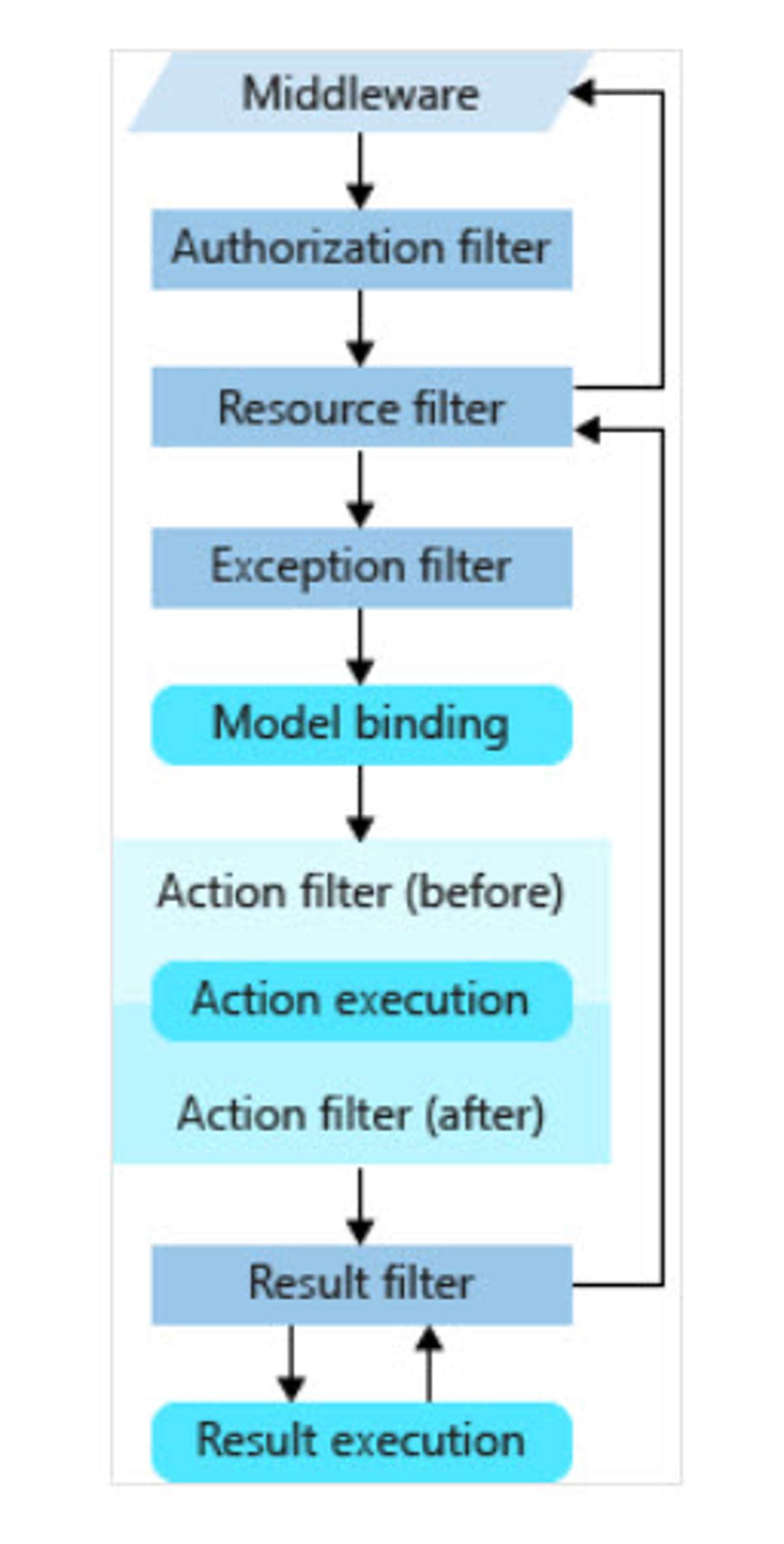Table of contents
Introduction
ASP.NET Core has revolutionized the world of web development with its efficiency, flexibility, and robust feature set.
Central to its design is the ability to handle requests asynchronously, providing a foundation for building highly scalable and performant web applications.
A key player in this architecture is the ActionFilterAttribute, a powerful component for customizing the action execution pipeline.
To understand how action filters work in ASP .NET Core - I encourage you to read Filters in ASP.NET Core on the MS website.

Diagram illustrating ASP .NET Core filters pipeline. Source: https://learn.microsoft.com/en-us/aspnet/core/mvc/controllers/filters?view=aspnetcore-8.0
Understanding ActionFilterAttribute in ASP.NET Core
ActionFilterAttribute in ASP.NET Core allows you to execute code before and after specific stages in the action execution pipeline.
It's beneficial for tasks like logging, error handling, or custom authorization.
While traditional synchronous execution works well for many scenarios, asynchronous execution, using OnActionExecutionAsync, becomes crucial for non-blocking I/O operations, thus enhancing the overall performance of your web applications.
The Pros and Cons of OnActionExecutionAsync
Pros:
- Improved Performance: Asynchronous execution prevents thread blocking, allowing for more efficient handling of multiple requests.
- Scalability: It enables the server to handle more concurrent requests by freeing up threads while waiting for I/O operations to complete.
- Responsiveness: Increases the responsiveness of your application, especially in scenarios involving long-running tasks.
Cons:
- Complex Error Handling: Asynchronous code can complicate error handling, making debugging harder.
- Potential for Deadlocks: Improper handling of asynchronous code can lead to deadlocks.
- Debugging Difficulty: Asynchronous code can be more challenging to debug due to its non-linear execution flow.
Implementing Dependency Injection with Async Action Filters
Dependency Injection (DI) is a design pattern that ASP.NET Core supports natively and encourages.
It promotes a loosely coupled and easily testable codebase.
In the context of action filters, DI allows you to inject services, like logging or custom business services, directly into your filter.
Hands-On: Building an Asynchronous Action Filter
Let's delve into the intricacies of building a FacebookPixelApiFilter using ActionFilterAttribute with asynchronous execution and dependency injection.
Understanding Constructor Injection Limitation
Initially, you might think of using constructor injection in your ActionFilterAttribute like this:
public class FacebookPixelApiFilter : ActionFilterAttribute
{
private readonly ILogger<FacebookPixelApiFilter> _logger;
private readonly SystemSettingsService _systemSettingsService;
private readonly FacebookPixelApiClient _facebookPixelApiClient;
public FacebookPixelApiFilter(
ILogger<FacebookPixelApiFilter> logger,
SystemSettingsService systemSettingsService,
FacebookPixelApiClient facebookPixelApiClient)
{
_logger = logger;
_systemSettingsService = systemSettingsService;
_facebookPixelApiClient = facebookPixelApiClient;
}
// ... (rest of the code)
}However, when you try to use this filter like [FacebookPixelApiFilter] above an action method, you will encounter a compilation error.
This happens because Action Filters in ASP.NET Core do not support constructor injection directly.
The framework attempts to instantiate the filter without providing any arguments, leading to an error.
Utilizing Service Locator Pattern with IServiceProvider
To work around this limitation, we use the Service Locator pattern within the OnActionExecutionAsync method.
Here, you dynamically retrieve the necessary services using IServiceProvider.
This approach allows you to access registered services without needing constructor injection.
Here's how you can modify the FacebookPixelApiFilter to use services via IServiceProvider:
public class FacebookPixelApiFilter : ActionFilterAttribute
{
public override async Task OnActionExecutionAsync(ActionExecutingContext context, ActionExecutionDelegate next)
{
// Retrieve services from the DI container
var serviceProvider = context.HttpContext.RequestServices;
var logger = serviceProvider.GetService<ILogger<FacebookPixelApiFilter>>();
var systemSettingsService = serviceProvider.GetService<SystemSettingsService>();
var facebookPixelApiClient = serviceProvider.GetService<FacebookPixelApiClient>();
// Add your logic here
// ...
await next(); // Proceed to the next action filter or action method
}
}In this implementation, GetService<T> is used to resolve the services at runtime.
This method is part of the IServiceProvider interface, integral to the .NET Core's dependency injection framework.
Why await next() is Crucial
The await next() call in the OnActionExecutionAsync method is crucial.
It ensures the continuation of the pipeline, allowing the action or the next filter in line to execute.
When you use await next(), the current filter asynchronously waits for the pipeline's completion and then resumes its process.
This is essential for maintaining the order and proper execution of filters and actions in your ASP.NET Core application.
Using the FacebookPixelApiFilter in a Controller
After creating the FacebookPixelApiFilter, the next step is to apply it to your controller actions.
In ASP.NET Core, you can apply action filters at the action method level, the controller level, or globally for all controllers.
Here's how to use the FacebookPixelApiFilter in each of these scenarios.
Applying the Filter to an Action Method
To apply the filter to a specific action within a controller, simply decorate the action method with the filter attribute.
This approach is ideal when you want the filter logic to apply only to particular actions.
public class HomeController : Controller
{
[FacebookPixelApiFilter]
public IActionResult Index()
{
// Your action logic here
return View();
}
// Other actions
}Applying the Filter to a Controller
If you want the FacebookPixelApiFilter to apply to all actions within a controller, you can decorate the controller class itself.
This ensures that every action method in the controller will execute the filter's logic.
[FacebookPixelApiFilter]
public class HomeController : Controller
{
public IActionResult Index()
{
// Your action logic here
return View();
}
// Other actions will also use the FacebookPixelApiFilter
}Applying the Filter Globally
For scenarios where you want your filter to be applied to all actions across all controllers, you can register the filter globally in the application’s startup configuration.
This approach benefits cross-cutting concerns like logging, error handling, or authorization.
In the Startup.cs file, add the filter to the MVC options in the ConfigureServices method:
public void ConfigureServices(IServiceCollection services)
{
services.AddControllersWithViews(options =>
{
options.Filters.Add<FacebookPixelApiFilter>();
});
// Other service configurations
}Handling Dependencies in Global Filters
When registering the filter globally, if your filter requires dependencies, you need to register it as a service to leverage the built-in dependency injection.
You do this in the ConfigureServices method:
public void ConfigureServices(IServiceCollection services)
{
services.AddScoped<FacebookPixelApiFilter>();
services.AddControllersWithViews(options =>
{
options.Filters.AddService<FacebookPixelApiFilter>();
});
// Other service configurations
}By applying the FacebookPixelApiFilter at the action method, controller, or global level, you can flexibly control its scope of influence in your ASP.NET Core application.
This flexibility allows you to tailor the filter application precisely to your application’s needs, ensuring that the filter logic is executed exactly where and when you need it.
Conclusion
Asynchronous action filters in ASP.NET Core offer a powerful way to handle requests efficiently, especially in I/O-bound scenarios.
By understanding the limitations of constructor injection in action filters and utilizing the Service Locator pattern, you can effectively implement asynchronous action filters with dependency injection.
This approach maintains a clean separation of concerns and adheres to the framework's guidelines, ensuring scalable and maintainable code.
🌐 Explore More: Interested in learning about ASP .NET Core and other web development insights? Explore our blog for a wealth of information and expert advice.


